The AMD Trinity Review (A10-4600M): A New Hope
by Jarred Walton on May 15, 2012 12:00 AM ESTAMD Trinity Gaming Performance
After the 3DMark results, you might be wondering if Intel has finally caught up to AMD in terms of integrated graphics performance. The answer is…yes and no. Depending on the game, there are times where a fast Ivy Bridge CPU with HD 4000 will actually beat out Trinity; there are also times where Intel’s IGP really struggles to keep pace. The good news is that at least everyone is now onboard the DX11 bandwagon, and compatibility with games has improved yet again for Intel. Here are our “Value” benchmark results for seven recent games; we’ll have more information in a moment.

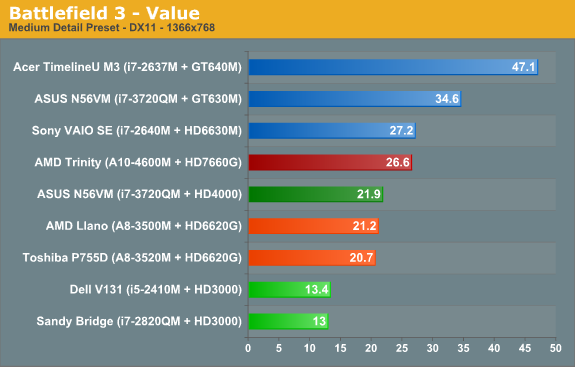
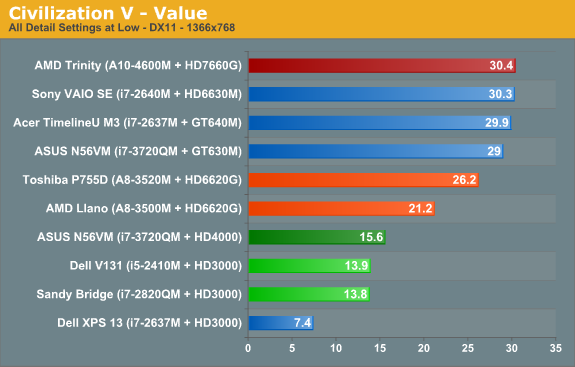

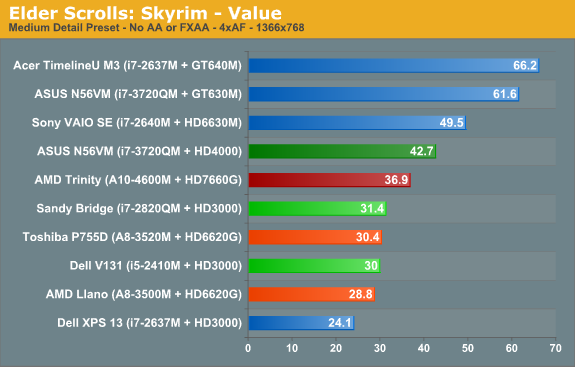
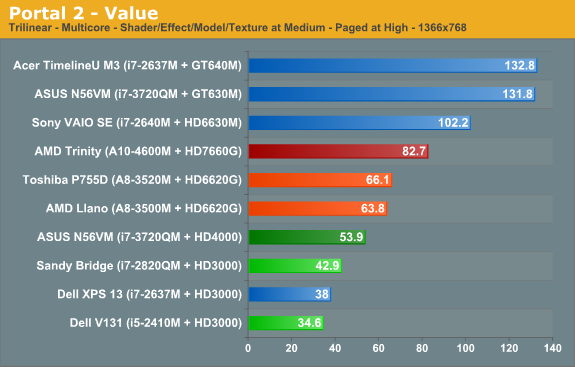
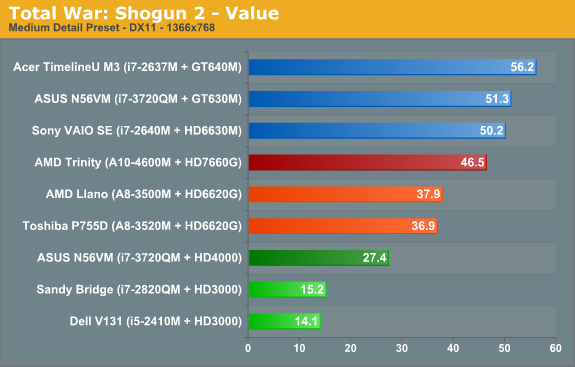
Out of our seven test titles, AMD’s Trinity leads any other IGP in four titles by a large margin. The other three titles actually have Ivy Bridge slightly ahead of Trinity, but the gaps aren’t nearly as big. Overall, the average performance across the seven games at our Value (medium) settings has AMD’s Trinity A10-4600M leading Intel’s i7-3720QM by 21%, and if we look at quad-core Sandy Bridge with HD 3000 (i7-2820QM) Trinity is 72% faster. Trinity is also around 20% faster than 35W Llano on average.
Let’s expand our gaming suite just a bit to see if things change, though. Just like we did with Ivy Bridge, we ran the eight games in our previous benchmark suite at medium detail settings. We can then compare performance across a wider 15 title selection to see how Trinity matches up against HD 4000, HD 3000, and HD 6620G (Llano). We’ll start with the bottom (HD 3000/Sandy Bridge) and move up.
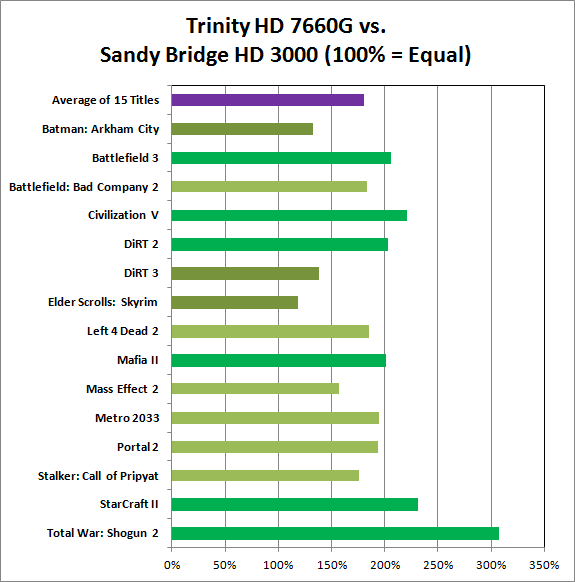
Llano’s HD 6620G was already faster than HD 3000, and Trinity’s HD 7660G is faster than Llano, so the Sandy Bridge gaming matchup is a landslide victory in AMD’s favor. The closest Intel can get is in the same three titles where Ivy Bridge leads Trinity: Batman: Arkham City, DiRT 3, and Skyrim. Here, however, HD 3000 can’t actually close the gap and HD 6620G is at least 20% faster than HD 3000, with an average performance improvement of nearly 80%.
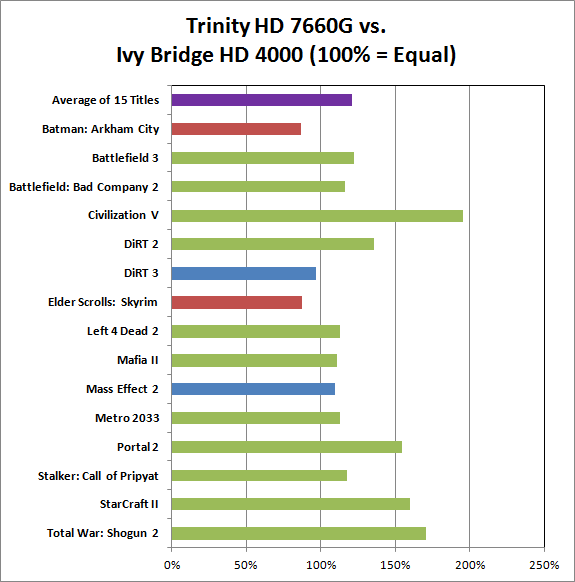
We found that across the same selection of 15 titles, Ivy Bridge and Llano actually ended up “tied”—Intel led in some games, AMD in others, but on average the two IGPs offered similar performance. This chart and the next chart will thus show a similar average increase in performance for Trinity, but the details in specific games are going to be different. Starting with Ivy Bridge and HD 4000, as with our earlier game charts we see there are some titles where Intel leads (Batman and Skyrim), a couple ties (DiRT 3 and Mass Effect 2), and the remainder of the games are faster on Trinity. Mafia II is close to our <10% “tie” range but comes in just above that mark, as do Left 4 Dead 2 and Metro 2033. The biggest gap is Civilization V, where Intel’s various IGPs have never managed good performance; Trinity is nearly twice as fast as Ivy Bridge in that title. Overall, it's a 20% lead for Trinity vs. quad-core Ivy Bridge.
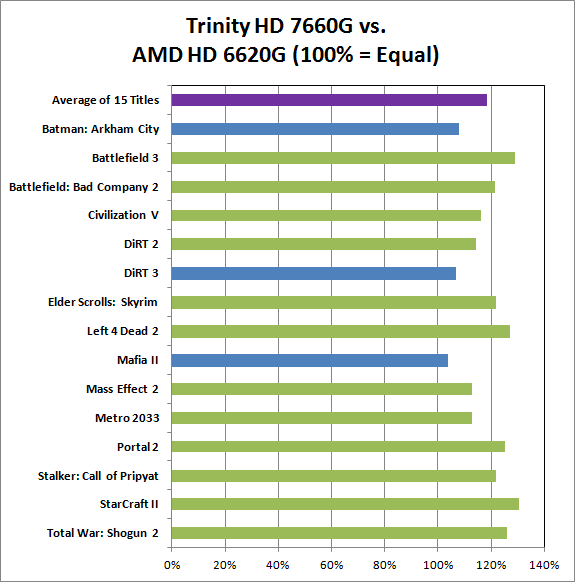
Against Llano, Trinity is universally faster, but the smallest gap is in Mafia II (3%) while the largest gap is in StarCraft II (30%). On average, looking at these games Trinity is only 18% faster than Llano. What’s not entirely clear from the above chart is whether we’re hitting CPU limitations, memory bandwidth limitations (remember that Llano and Trinity share bandwidth with the rest of the system), or perhaps both. At our chosen settings, what is clear is that Trinity’s “up to 56% faster” graphics never make it that high.
We saw 35-45% higher scores in 3DMark 11 and Vantage, which tend to remove the CPU from the equation more than actual games, so our guess would be that if AMD continues with their APU plan they’re going to need to work more on the CPU side of the equation. We also see the same thing looking at the VAIO SE scores in the earlier gaming charts: the HD 6630M scores are 20% faster on average, but much of that appears to come from the faster CPU rather than the GPU.










271 Comments
View All Comments
Beenthere - Tuesday, May 15, 2012 - link
Many students game on laptops and that's a large market segment with many people desiring portability by necessity these days.aliasfox - Tuesday, May 15, 2012 - link
Your average kid going into undergrad who doesn't care enough to spend more than $1k (or more than $700) for a computer will be pleasantly surprised when he/she fires up some random game - and releasing these machines right now is perfect timing to get product on the shelves for college back-to-school season.It's really all about 'good enough' on SC2 or Portal or whatever else people will pick up for a few hours a week. They don't care about 100 fps at insane external monitor resolutions with megapixels worth of textures, but if they can get >20-30 fps at 768p or 900p on whatever they might throw at it, they're happy enough.
I used to be of them.
mikato - Wednesday, May 16, 2012 - link
Me too. I played Quake 3 on an 8MB video card for quite a while on my desktop and everything worked well enough for me to kick butt with the rail gun :) It was great to play for a few minutes or an hour to unwind a bit.Caltek9 - Tuesday, May 15, 2012 - link
jwcalla,I'm actually totally interested in gaming on a lower-end laptop right now, and am trying to decide whether to wait for Trinity or not. I'm going to grad school (undergrad and building gaming towers was many years and 2 children ago), and need a light laptop with good battery that I can play recent games on (Diablo III, Kingdoms of Amalur, Saints Row the Third, Borderlands). The reason the Trinity setup is intriguing to me is because if the GPU works out, I can get (supposedly/hopefully) a very slim laptop that can do this, instead of a heavier one. I'll be going to grad school in Europe, and every pound I can shave off before I travel is a good thing! I've been a console gamer for far too long (since abandoning the PC after undergrad), so I'm used to not having the best looking graphics. As long as it can play a game smoothly, and at decent graphical settings, I'm fine with that.
I get a bit sad when seeing the Trinity CPU numbers, but keep trying to convince myself that it won't matter to me, since I'll mainly be typing papers, and surfing the Internet, and not transcoding anything with gaming on the side. I'm writing this on an Intel-based Mac, so I'm not a fanboy of either AMD.
Bottom Line: I want cheap, light, good battery, and the ability to play recent games at medium settings. Trinity seems to be able to do this better than Ivy Bridge, at least in these early reviews.
SIDE NOTE: Until I see an actual laptop with Trinity in the wild, this is my current choice for a replacement laptop (Sager NP6110/Clevo W110ER): http://www.xoticpc.com/sager-np6110-clevo-w110er-p...
I'm a bit worried about the screen and keyboard sizes for papers, but suppose I could hook them up to externals.
Gigantopithecus - Tuesday, May 15, 2012 - link
PCPer shows the A10-4600M absolutely trouncing the i7-3720QM (http://www.pcper.com/files/review/2012-05-13/gamet...What explains the dramatic discrepancy between their results and Anandtech's?
Gigantopithecus - Tuesday, May 15, 2012 - link
...in Skyrim, and here's a working link: http://www.pcper.com/files/review/2012-05-13/gamet...tipoo - Tuesday, May 15, 2012 - link
Anandtech tested at low details, in your link its medium. The HD4000 has decent pixel fill rate, but pretty bad pixel shader performance. So more details = it falls further behind.JarredWalton - Tuesday, May 15, 2012 - link
Good try, but you're wrong. We test at Medium details, with FXAA disabled and anisotropic filtering set at 4x. We also have the high resolution texture pack installed, though I'm not sure if it's always active at low details. Finally, Skyrim is a massive game. I specifically ran around looking for areas (on my desktop system) where performance was lower so that we could give more of a "this is as bad as it gets" score. That ended up being near Whiterun. Go into dungeons and such and the game runs two or three times as fast as our benchmark section.tipoo - Tuesday, May 15, 2012 - link
My mistake, I read "value" and assumed low settings. So if they were both at medium, why are the winner and loser completely flipped? Your explanation would explain the lower framerate, but not a complete flipping of winner and loser.JarredWalton - Tuesday, May 15, 2012 - link
It could be that Whiterun has lower framerates because of CPU bottlenecks as opposed to GPU bottlenecks. I honestly don't know, and I don't know what areas others are using for testing. I suppose I could always try benchmarking a different section of the game to see what happens.It's also possible that FXAA and anti-aliasing in general is the cause of the discrepancy. I never turn on AA personally until I'm at the point where I've maxed out other settings and I still have room to spare. Jaggies just don't bother me all that much, particularly at native resolution on LCDs, and FXAA is basically a blur filter for the whole screen -- you lose jaggies as well as details.